Motorola Xoom Review: The First Honeycomb Tablet Arrives
by Anand Lal Shimpi on February 23, 2011 11:57 PM ESTPerformance
With Honeycomb, Google enabled full GPU acceleration across the OS. As a result, I had hoped that we’d have a very Windows Phone 7 like experience in Android 3.0. For the most part, it’s similarly smooth, but it’s still not quite perfect.
Performance in Honeycomb seems even more dependent on background apps than with earlier versions of Android. I’m not sure if that’s because Honeycomb is less aggressive about kicking processes out of memory or if I’m simply doing more with the OS on a larger screen, but I found myself killing tasks manually more frequently in Honeycomb than I did on Froyo. It’s also possible that with faster hardware and a faster OS that any slowdown, even if only minor, is more perceptible.
Swiping between home screens is butter smooth under Honeycomb, as is interacting with widgets and notifications. Applications launch quickly and scrolling in them is smoother than any other Android release. Even scrolling in the browser is finally smooth on Android, although I don’t believe it’s quite up to par with iOS/WP7. Granted Honeycomb doesn’t support Flash yet so it’s too early to tell how Flash integration will change the browsing experience, but I wonder if the delay on integrating flash has to do with ensuring that browser scrolling performance isn’t hurt.
As we saw with the Atrix 4G, performance benchmarks may be slower on the Xoom due to its higher native resolution (1280 x 800) than the competitors. This is particularly evident in the 3D gaming tests. I almost wonder if we'll begin seeing higher performing SoCs in tablets going forward, with lighter hardware being used in smartphones. It's clear that these smartphone SoCs, while fine for lower res smartphones, don't have the compute horsepower or memory bandwidth to cope with higher resolution displays.
I'm also not entirely sure what's going on in the Quadrant results as there are some significant drops in performance on the Xoom vs. Atrix. This could be a Honeycomb thing or an issue with the benchmark itself.
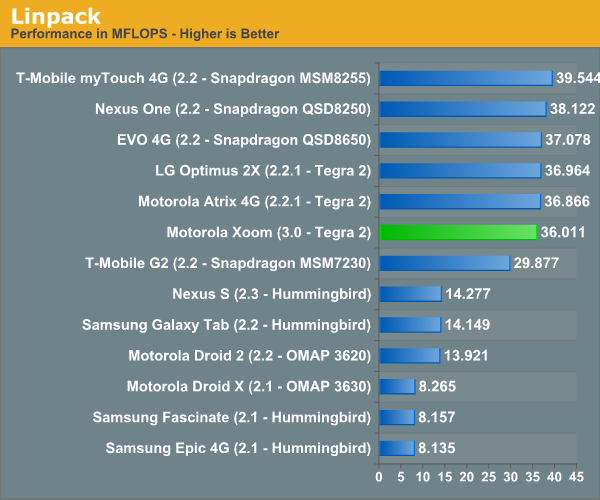
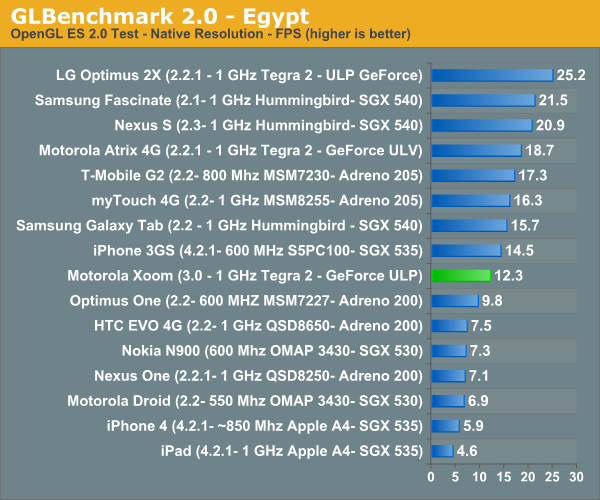
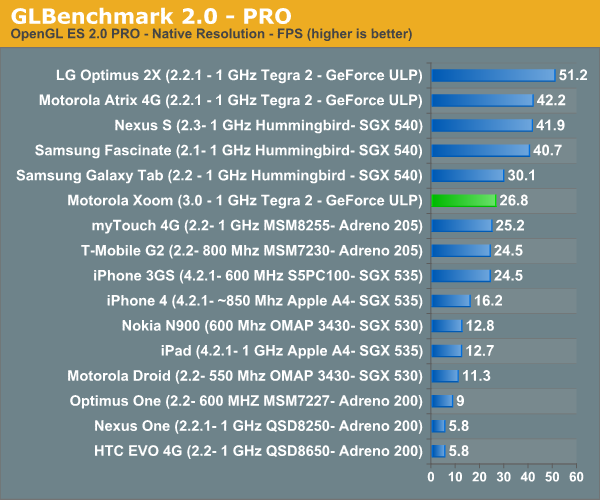

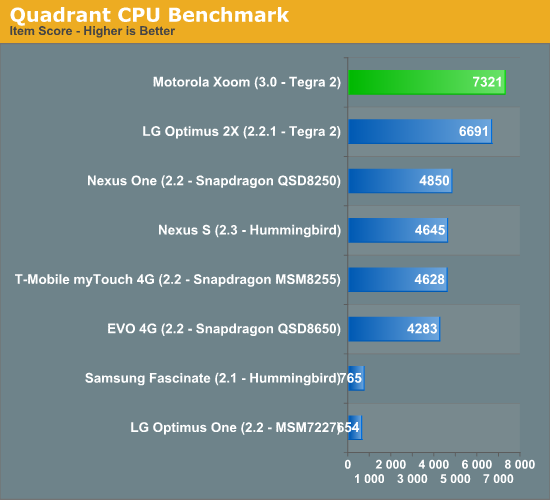
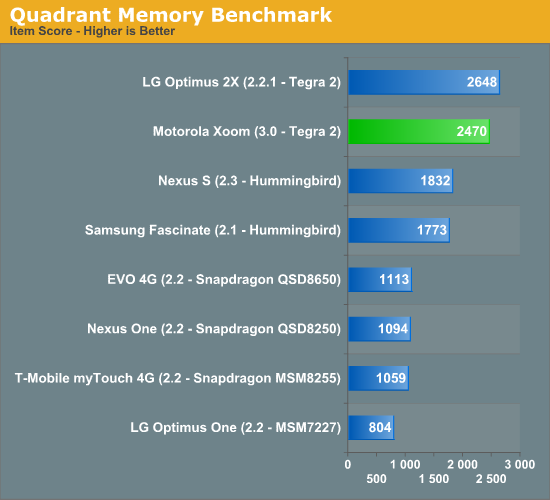
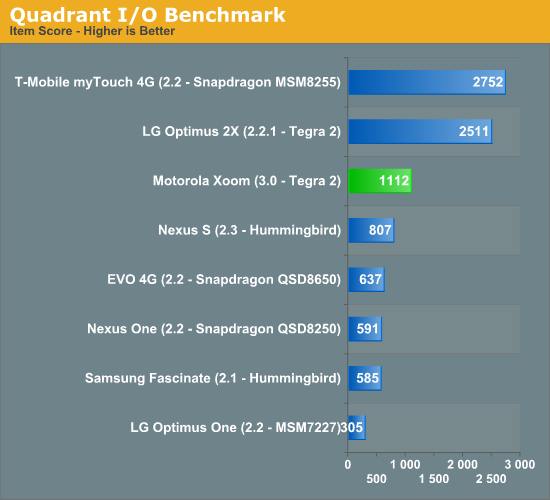
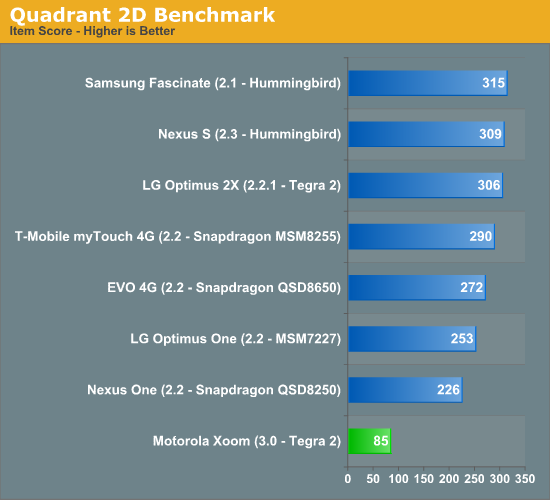
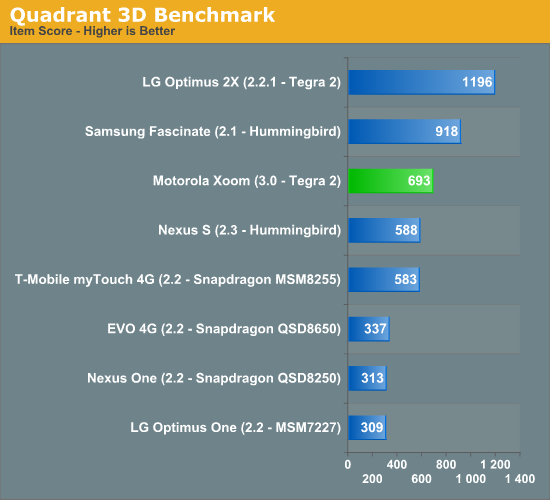
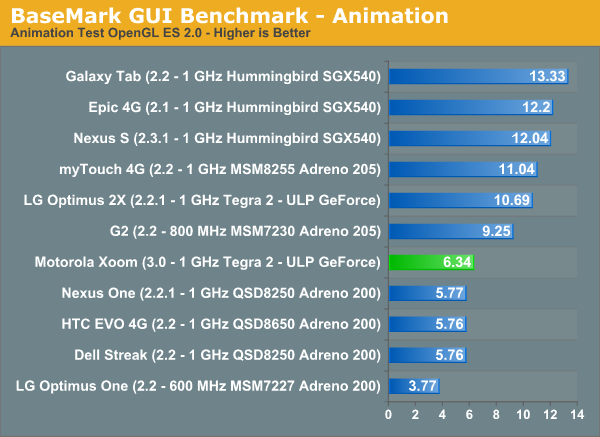
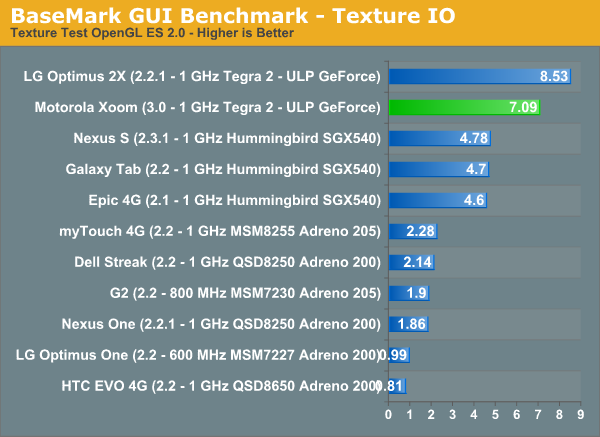

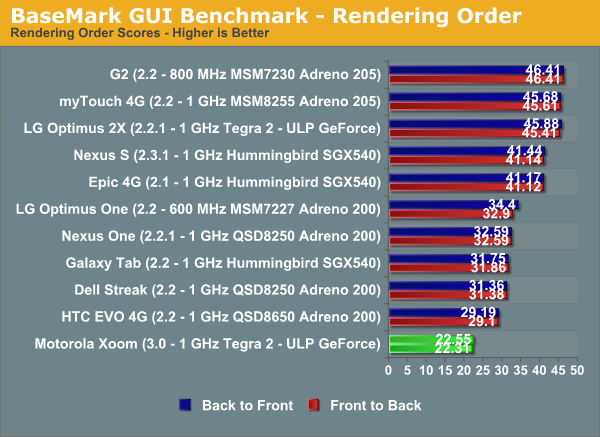










112 Comments
View All Comments
punjabiplaya - Thursday, February 24, 2011 - link
Looks good, I'm really tempted to pick one up (wifi model) if it truly is $600. Any word from Google on any updates to fix the crashing? I assume with updates (including driver optimizations) it can only get faster and there's no way that Google/Motorola isn't aware of the crashing apps.LeftSide - Thursday, February 24, 2011 - link
Don't hold your breath. I have an Epic 4g and just now got the 2.2 update. Google needs to standardize their update system. Until they do, I will not buy another Android device. Waiting for months just for an outdated update, so that you can download and use the latest apps (skype) is unacceptable.Impulses - Thursday, February 24, 2011 - link
Blame Samsung, not Google. Most HTC & Motorola devices were running 2.2 as of last September. My EVO got Froyo (2.2) in August, a mere two months after it's release (and only like there months after Froyo itself launched). People need to start doing some research and stop rewarding manufacturers that are lousy with updates, like Samsung and Sony Ericson.daveloft - Thursday, February 24, 2011 - link
I say blame the carriers. All six carriers in Canada carrying the Galaxy S device released 2.2 before any of the American carriers. This seemed to be the situation around the world as well.Impulses - Thursday, February 24, 2011 - link
Yeah at this point it's their fault, it still took Samsung twice as long to release the updates as it took other manufacturers tho. Sprint and T-mobile recently updated their Galaxy S variants to 2.2 btw, so Verizon and AT&T are slacking off the most... Verizon has half a dozen other Android options tho, until today (Atrix) AT&T had no alternative to the Captivate, besides an iPhone.ph00ny - Monday, March 7, 2011 - link
At the same time, their devices came out later those other devices. Also all the international iteration of galaxy s had froyo long before any north america based galaxy S phones. Look at HTC Aria. AT&T is the worst carrier in terms of device update due to the fact that they want to restrict the device as much as they can. Look at the issues with hsupa with atrix.BTW i have a captivate running 2.2.1 and i had froyo running since last year which was based on the international version of galaxy s
kkwst2 - Thursday, February 24, 2011 - link
Blame Canada.Milleman - Sunday, February 27, 2011 - link
Blame Terrance and Phillip!punjabiplaya - Thursday, February 24, 2011 - link
The reason I was asking is because there is no manufacturer skin. Honeycomb is unmolested by Motorola, so Google should be able to get updates to the device without Motorola having to customize their skin, then the carrier customizing that.Enormously Hatworthy - Thursday, February 24, 2011 - link
Yep, since this is the reference hardware for the platform, you'll get OTA updates directly from Google. No carriers or OEMs to screw things up.No word from google though... I suppose they don't want to draw attention to the bugs on the first day of release. I'd bet there'll be a quiet update issued sometime in the next week or two.